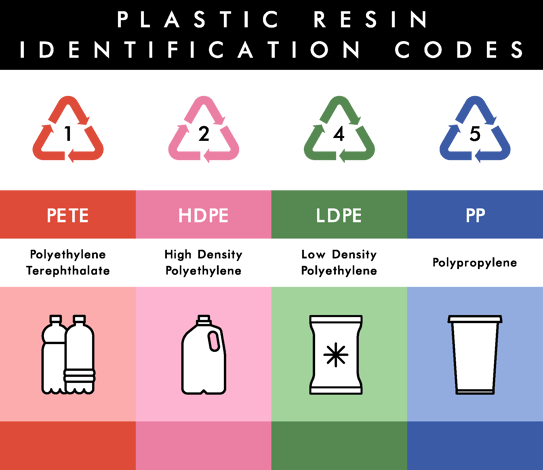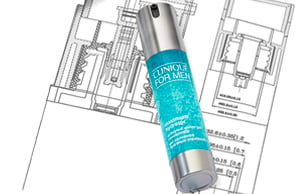Plastic is one of the most used materials in the world today, but did you know just how many different types of plastic there are? Hundreds! Plastics are produced in so many different composites, with so many different characteristics and uses, that here we’re just going to focus on the most common types of plastic that we use in our packaging products.
Polypropylene (PP)
The annual U.S. consumption volume of polypropylene is approximately 37 billion pounds and is second only to polyethylene. Polypropylene comes in many different grades which offer a wide range of properties. Some general characteristics of PP include; good tensile and impact strength, high chemical resistance, relatively low cost, and versatility. PP has a glass transition temperature of approximately -20 degrees Celsius, which makes it flexible at room temperature. It also has a relatively high melting point of approximately 165 degrees Celsius. PP is a semi-crystalline material that has a relatively high crystallinity of 50%-85%. This accounts for its translucency or hazy appearance in its natural form. The crystalline regions refract the transmission of light through the PP matrix and destroy clarity. Clarified grades of PP are available for applications that require excellent contact clarity. PP is flexible and is easily processed. PP typically does not have great UV resistance, but a clear protective topcoat can be applied to packages made from PP. These combined properties make PP a viable and cost-effective material for high production volumes. PP is used in a wide variety of applications, including, but not limited to automotive, agriculture, medical / healthcare, packaging, fibers, building and construction, leisure / outdoors.
Polyethylene (PE)
Polyethylene is a general purpose or commodity thermoplastic that is characterized alongside with Polypropylene in the Olefin family. PE has the highest annual production volume of all plastics due to its low cost. PE has a low specific gravity of approximately 0.95 g/cc but changes slightly with the different characterizations of Polyethylene. PE is a family of material that range from Low Density Polyethylene, (LDPE), to Medium Density Polyethylene, (MDPE), to High Density Polyethylene, (HDPE), all the way to Ultra High Molecular Weight Polyethylene, (UHMWPE). PE’s high crystallinity account for its relatively high melting point, (ranging from 110 degrees Celsius for LDPE to 138 degrees Celsius for HDPE), its good chemical resistance, and its high translucency. The crystalline structures disrupt light transmission through the matrix and destroy clarity. PE has a low glass-transition temperature of -120 degrees Celsius, therefore it is relatively flexible at room temperature, giving it good toughness and impact resistance. PE has relatively low tensile strength, and poor UV-resistance. If the intended application requires extended sunlight exposure, weatherability agents can be added to improve the polymer’s resistance to UV-light. Proper selection of a grade of polyethylene resin for use in applications is based off three important properties: density, melt index, and molecular weight distribution, so be sure to consult with out experts to help you find the best solution for your product.
Polyethylene Terephthalate (PET)
Polyethylene Terephthalate (PET) is the most widely recycled plastic in the world. PET features excellent mechanical, optical, and electrical properties. PET has high dimensional stability, low shrinkage on heating, good chemical resistance, and very good electrical insulation. PET is a transparent and strong, tough, and stiff polymer with both excellent gas and moisture barrier properties. However, PET does need to be dried before processing in order to minimize hydrolysis, or the degradation due to the presence of moisture. This material can be utilized in several different manufacturing processes including, injection molding, blow molding, injection blow molding, and injection stretch blow molding. This give PET the versatility to be used in a wide variety of applications. The two main uses for PET resin in fiber-type applications, and pop-bottle applications.
Copolymers (PETG/PCTA/PCTG)
PETG, PCTA, and PCTG are glycol-modified copolyesters, or otherwise known as “glass” polymers. These materials are amorphous copolymer thermoplastics with above average chemical resistances when compared to other amorphous materials such as ABS or PMMA. They have excellent physical properties for a wide variety of packaging types and offer superior clarity over clarified PP. Glass polymers have the same clarity and high luster as glass and are used for thick-walled containers for products such as high-quality cosmetics. They also have excellent chemical resistance, impact resistance and other characteristics. The variations of copolyesters differ in chemical composition but have relatively similar properties. PETG offers glass-like clarity and high stiffness. PCTG also offers excellent clarity and better impact resistance and elongation than Polycarbonate (PC), making is suitable for relatively high load bearing applications. PCTA has a higher heat deflection temperature (HDT), toughness, and impact strength than PETG. Copolyesters are widely used in the cosmetic industry because their superior aesthetic qualities make for a unique and eye-catching package. These materials offer brilliant sparkle and clarity, a density that approaches the feel of glass, ease of decoration, excellent chemical resistance, significant impact resistance, and the ability to mold thick walled parts without any haze or fogginess. Others have found use for copolyesters in the medical packaging, appliance and consumer industries.
Poly Methyl Methacrylate (PMMA)
PMMA, being the first transparent thermoplastic material, attributed to the use of plastic materials as a substitute for optically transparent glass applications. PMMA is considered a quasi-commodity thermoplastic because it is slightly more expensive than typical commodity thermoplastics such as PE, PP, PVC, and PS. This is due to the combination of its physical and mechanical properties such as clarity, weatherability, and average to high strength. This material also has high dimensional stability, allowing it to be molded in either thin wall or thick wall applications. These properties make PMMA an optimal choice for the cosmetic packaging industry. This material is a naturally amorphous thermoplastic material, and has a refractive index of 1.49, which is comparable to glass which has a refractive index of 1.60. PMMA has theoretically the maximum obtainable light transmission of plastic materials at 92-93%. It also has excellent UV light resistance and weatherability, making it a suitable material choice for applications where extended outdoor use is likely. Although PMMA has good chemical resistance for an amorphous material, it is however susceptible to strong acids, alcohols, and ethers, so be sure to consult with our experts with regards to the contents of your bulk when considering to use PMMA as the intended material selection for the product.
Acrylonitrile Butadiene Styrene (ABS)
The current U.S. production level for ABS is approximately 1.2 billion pounds per year. The main reason for the widespread use of ABS is its unique combination of properties that can be attributed to the composition of its three main components. The composition consists of approximately 15-35% acrylonitrile, 5-30% butadiene, and 40-60% styrene. The acrylonitrile provides chemical resistance, high strength and heat stability; the butadiene provides toughness, and impact resistance even at low-temperature properties; while the styrene provides rigidity, glossiness and improved processability. Variations in the percentages yield different resin grade which offer unique characteristics and properties. ABS is susceptible to UV-light and will discolor in its natural state with extended exposure to sunlight. This issue can be overcome through the incorporation of in mold or sprayed colors, and/or the use of a UV topcoat. ABS can be process with all thermoplastic processing techniques, including, but not limited to, extrusion, rotational molding, thermoforming, injection molding, and injection blow molding. This, along with its unique range of properties contribute to its use in a wide variety of applications.
PCR Material
PCR is an acronym for Post-Consumer Recycle, which has become more and more sought after and is commonly misunderstood and associated with other forms of recycle. Learn more about PCR here.
Besides, if you have any questions or would like to know more about any type of plastic that we use in our packaging products, contact us now.









